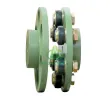What are flexible couplings used for?
Flexible couplings serve as crucial components in various mechanical systems, providing essential functions to connect and transmit power between two shafts. These couplings offer flexibility and accommodate misalignments, contributing to the smooth and efficient operation of machinery. Here are several common uses and applications of flexible couplings:
Shaft Misalignment Compensation:
One of the primary functions of flexible couplings is to compensate for misalignments between two connected shafts. These misalignments can be angular, radial, or axial. Flexible couplings help maintain proper alignment, preventing excessive wear on components and reducing vibrations.
Power Transmission:
Flexible couplings transmit power from one shaft to another while allowing for some degree of flexibility. They are commonly used in drivetrains, gearboxes, and other power transmission systems to transfer rotational motion without causing undue stress or damage to connected components.
Vibration Dampening:
Flexible couplings absorb and dampen vibrations generated during the operation of rotating machinery. This is particularly important in applications where minimizing vibration is critical to prevent damage to sensitive equipment or to improve the overall comfort and safety of the system.
Torque Limiting:
In certain applications, Flexible Pin Bush Couplings act as torque limiters to protect machinery from excessive loads. They can disengage or slip when the torque exceeds a predetermined threshold, preventing damage to the connected components.

Reducing Shock Loads:
Flexible couplings help mitigate shock loads by providing a degree of cushioning during sudden starts, stops, or changes in load. This feature is beneficial in applications where abrupt changes in motion could otherwise lead to damage or premature wear.
Noise Reduction:
The flexibility and damping properties of flexible couplings contribute to noise reduction in mechanical systems. They absorb and minimize the transmission of noise generated by the movement of rotating machinery, creating a quieter working environment.
Expansion and Contraction Compensation:
Flexible couplings are used in applications where thermal expansion and contraction occur. They accommodate the changes in shaft length that result from temperature variations, preventing binding or stressing of components.
Connection of Dissimilar Shafts:
When connecting shafts with different sizes or types, flexible couplings provide a means to bridge the gap and enable the efficient transfer of power. This is common in applications where the driving and driven components have distinct specifications.
Pump and Motor Connections:
In pump and motor systems, flexible couplings are frequently employed to connect the motor shaft to the pump shaft. This allows for smoother power transmission, compensates for misalignments, and reduces the risk of damage to the pump or motor.
Motion Control Systems:
Flexible couplings play a crucial role in motion control systems, including robotics and CNC machinery. They enable precise and accurate transmission of motion while compensating for any misalignments or vibrations that could affect the performance of these systems.
Marine Applications:
In marine environments, where vessels are subjected to various forces and movements, flexible couplings are used in propulsion systems to connect the engine to the propeller shaft. This helps absorb shocks and vibrations, enhancing the overall reliability of the marine propulsion system.
In summary, flexible couplings are versatile components that find application in a wide range of industries and machinery. Their ability to compensate for misalignments, absorb vibrations, and provide flexibility makes them essential for ensuring the smooth and efficient operation of various mechanical systems.
Previous: Function of Stator and Rotor
Next: How Copper Is Forged?
If you are interested in sending in a Guest Blogger Submission,welcome to write for us!




Comments
0